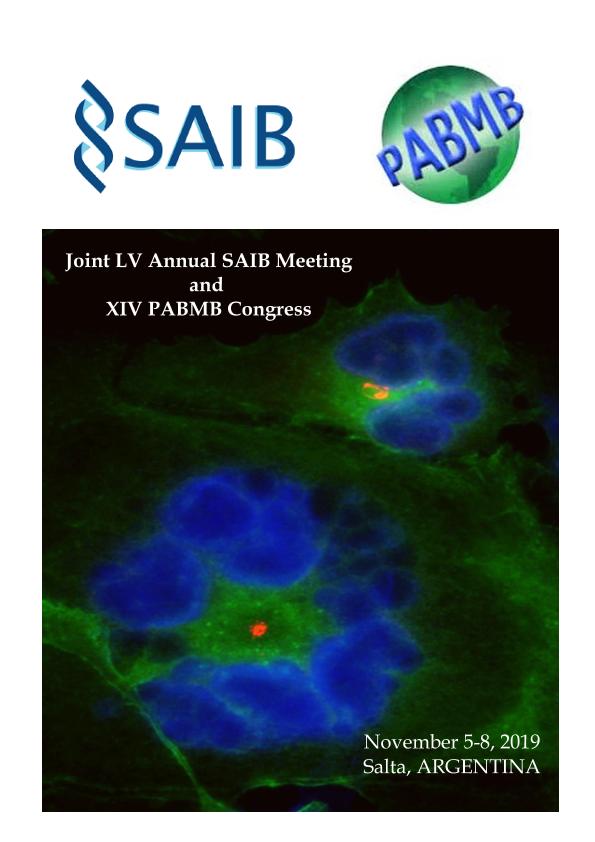Evento
Glyphosate removal by riparian vegetable species and isolation of associated bacteria
Giaccio, Graciela Marta; Aparicio, Virginia Carolina ; Estévez, Maria Cristina
; Estévez, Maria Cristina ; de Gerónimo, Eduardo
; de Gerónimo, Eduardo ; Corral, Raúl Alejandro
; Corral, Raúl Alejandro ; Dávila Costa, José Sebastián
; Dávila Costa, José Sebastián ; Alvarez, Analia
; Alvarez, Analia
 ; Estévez, Maria Cristina
; Estévez, Maria Cristina ; de Gerónimo, Eduardo
; de Gerónimo, Eduardo ; Corral, Raúl Alejandro
; Corral, Raúl Alejandro ; Dávila Costa, José Sebastián
; Dávila Costa, José Sebastián ; Alvarez, Analia
; Alvarez, Analia
Tipo del evento:
Reunión
Nombre del evento:
The LV Annual SAIB Meeting and XIV PABMB Congress
Fecha del evento:
05/11/2019
Institución Organizadora:
Sociedad Argentina de Investigación en Bioquímica y Biología Molecular;
Título de la revista:
Biocell
Editorial:
Tech Science Press
ISSN:
0327-9545
Idioma:
Inglés
Clasificación temática:
Resumen
Glyphosate (Gly) is the most used herbicide in Argentina. Consequently, a higher occurrence of Gly and its major metabolite (AMPA) in differentenvironmental compartments are currently found. Plants growing in such environments can reduce pollutant loads. Contaminated soils andvegetation represent a source of potentially beneficial plant associated-bacteria that could be used within microbial-assisted remediation strategies.The objectives of this study were (1) to isolate bacterial strains from Gly contaminated soil and rhizosphere of Salix fragilis (Sf) and Festucaarundinacea (Fa) spontaneously grown on soils contaminated, and (2) to evaluate Gly and AMPA content in soil and plant tissue of Sf and Fagrown in a greenhouse experiment. Samples of top soils contaminated with Gly and samples of Sf and Fa growing in the surroundings of theClaromecó stream (Tres Arroyos) were collected. For the bacterial isolation, one g of bulk soil (S) and rhizosphere soil (R) was suspended in asterile solution. Soil suspensions were diluted and plated. After 7 days of incubation, distinct colony morphotypes isolated were screened accordingto use Gly (0.5 g L-1) as only carbon source (minimal medium+Gly) and to use Gly as only P source (mineral salt medium+sodium glutamate+Gly). For the greenhouse experiment, pots were filled with 2 kg of contaminated soil and one Sf cutting and 6 Fa seedlings were planted per pot, for 3months. Four pot replicates were prepared for each treatment, including control pots. At the end of the experiment, plants were harvested, and soilsamples were taken for Gly and AMPA analysis by UPLC-MS/MS. Sixty-nine different colonies morphotypes, 23 from S and 46 from R (26 fromFa and 20 from Sf) were isolated. Seventeen of the isolates were able to grow on Gly as source of P and 14 were able to grow using Gly as sourceof C. Five of different bacterial morphotypes were able to grow using Gly as source of P and C. In the greenhouse experiment, Gly and AMPAinitial content in soils were 5512 ± 1369 μg kg-1 and 2353 ± 181 μg kg-1, (respectively). At the end of the assay, Gly final content was 325 ± 23μg kg-1 (Sf) and 25 ± 2 μg kg-1 (Fa) showing both a noticeable decrease in planted soils. AMPA final content was also decreased in Fa (822 ± 104μg kg-1) while for Sf AMPA was enhanced (3853 ± 207 μg kg-1). Gly detected in plant biomass was 513 ± 97 μg kg-1 (Sf) and 164 ± 50 μg kg-1(Fa). AMPA content in plants was 2385 ± 726 μg kg-1 (Sf) and 575 ± 87 μg kg-1 (Fa). In control pots, differences in contaminant content were notsignificant during the assay. Since Fa treatment showed decreased values of Gly and AMPA both in plant and soil, and five of different bacterialmorphotypes were able to grow using Gly as a source of P and C, bioassays combining both bacterial inoculant and Fa are currently in course.The microbial-plant system could be considered a promising tool for the phytoremediation of Gly and AMPA.
Palabras clave:
GLYPHOSATE
,
BIOREMEDIATION
,
VEGETABLE SPECIES
Archivos asociados
Licencia
Identificadores
Colecciones
Eventos(PROIMI)
Eventos de PLANTA PILOTO DE PROC.IND.MICROBIOLOGICOS (I)
Eventos de PLANTA PILOTO DE PROC.IND.MICROBIOLOGICOS (I)
Citación
Glyphosate removal by riparian vegetable species and isolation of associated bacteria; The LV Annual SAIB Meeting and XIV PABMB Congress; Salta; Argentina; 2019; 147
Compartir



